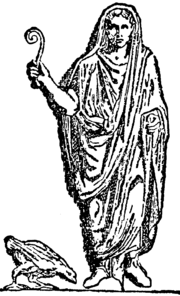
Back توسم الطير Arabic Auspisiya Azerbaijani Аўспіцыі Byelorussian Auspici Catalan Auspicia Czech Auspicier Danish Auspizien German Auspicio Spanish Augurio Basque شگون Persian

Augury was a Greco-Roman religion practice of observing the behavior of birds, to receive omens. When the individual, known as the augur, read these signs, it was referred to as "taking the auspices". "Auspices" (Latin auspicium) means "looking at birds". Auspex, another word for augur, can be translated to "one who looks at birds".[1] Depending upon the birds, the auspices from the gods could be favorable or unfavorable (auspicious or inauspicious). Sometimes politically motivated augurs would fabricate unfavorable auspices in order to delay certain state functions, such as elections.[2] Pliny the Elder attributes the invention of auspicy to Tiresias the seer of Thebes.[3]
This type of omen reading was already a millennium old in the time of Classical Greece: in the fourteenth-century BC diplomatic correspondence preserved in Egypt called the Amarna correspondence, the practice was familiar to the king of Alasia in Cyprus who needed an "eagle diviner" to be sent from Egypt.[4] This earlier, indigenous practice of divining by bird signs, familiar in the figure of Calchas, the bird-diviner to Agamemnon, who led the army (Iliad I.69), was largely replaced by sacrifice-divination through inspection of the sacrificial victim's liver—haruspices—during the Orientalizing period of archaic Greek culture. Plato notes that hepatoscopy held greater prestige than augury by means of birds.[5]
One of the most famous auspices is the one which is connected with the founding of Rome. Once the founders of Rome, Romulus and Remus, arrived at the Palatine Hill, the two argued over where the exact position of the city should be. Romulus was set on building the city upon the Palatine, but Remus wanted to build the city on the strategic and easily fortified Aventine Hill. The two agreed to settle their argument by testing their abilities as augurs and by the will of the gods. Each took a seat on the ground apart from one another, and, according to Plutarch, Remus saw six vultures, after which Romulus saw twelve. The two clashed over whether the preference of the gods was indicated by Remus seeing vultures before Romulus did, or by Romulus seeing twelve vultures while Remus saw six. Vultures were pre-eminent in Roman augury, furnishing the strongest signs an augur could receive from a wild bird. They were subject to protective taboos and also called sacred birds.[6]
- ^ auspic-, auspec- + (Latin: to look, to observe in order to make a prediction; to see omens; from auspex [genitive form auspicis] avi-, stem of avis, "bird" plus -spex, "observer", from specere)
- ^ Troxler, Howard, "Electoral Abuse in the Late Roman Republic" (2008). Graduate Theses and Dissertations. https://scholarcommons.usf.edu/etd/537
- ^ Gaius Plinius Secundus, Naturalis Historia 7.203.3
- ^ J.A. Knudtzon, Die El-Amarna Tafeln (1915:no. 35.26) noted in Walter Burkert, The Orientalizing Revolution: Near Eastern Influences on Greek Culture in the Early Archaic Age (1992), p 42.
- ^ Walter Burkert 1992:49, noting Plato's Phaedrus 244C.
- ^ classicsvic (2022-08-19). "The Most Sacred Birds: Explaining the Vulture's Significance in Roman Augury". Classical Association of Victoria. Retrieved 2023-01-17.
© MMXXIII Rich X Search. We shall prevail. All rights reserved. Rich X Search